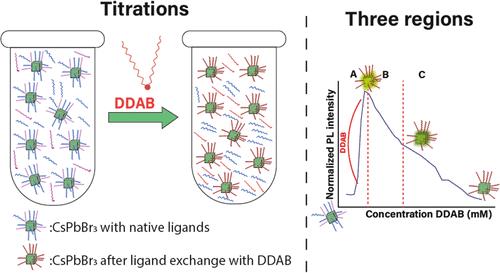Quantitative Correlation between Ligand Shell Composition and Photoluminescence in CsPbBr3 Nanocrystals with Mixed Didodecyldimethylammonium Bromide and Oleic Acid Ligands
IF 3.2
3区 化学
Q2 CHEMISTRY, PHYSICAL
引用次数: 0
Abstract
The optoelectronic properties of halide perovskite nanocrystals are strongly determined by their surface chemistry; therefore, their improvement hinges on a detailed understanding and control of their surface properties. Given that most recombination occurs at the surface, the ligand-induced reconstruction of the lattice can remove or add trapping sites that increase or decrease the emission quantum yield. Great strides have been made in elucidating the binding sites of different ligands along with their modification of the energy levels. However, quantitative measurement has not been fully achieved. In this work, we present a quantitative correlation between the composition of a mixed-ligand shell containing oleic acid (OA) and didodecyldimethylammonium bromide (DDAB) and the photoluminescence of CsPbBr3. We identify three different regions corresponding to three different ligand shell compositions with their associated recombination dynamics and find that an added concentration of 0.5 mM of DDAB results in a surface with both Pb and Br defects maximally passivated by the ligand shell.

二十二烷基二甲基溴化铵与油酸混合配体CsPbBr3纳米晶体配体壳组成与光致发光的定量相关性
卤化物钙钛矿纳米晶体的光电性能在很大程度上取决于其表面化学性质;因此,它们的改进取决于对其表面性质的详细了解和控制。考虑到大多数重组发生在表面,配体诱导的晶格重建可以去除或增加捕获位点,从而增加或降低发射量子产率。在阐明不同配体的结合位点以及它们的能级修饰方面已经取得了很大的进展。然而,定量测量尚未完全实现。在这项工作中,我们提出了含有油酸(OA)和二十二烷基二甲基溴化铵(DDAB)的混合配体壳的组成与CsPbBr3的光致发光之间的定量相关性。我们确定了三个不同的区域对应于三种不同的配体壳组成及其相关的重组动力学,并发现添加浓度为0.5 mM的DDAB会导致配体壳最大程度地钝化Pb和Br缺陷的表面。
本文章由计算机程序翻译,如有差异,请以英文原文为准。
求助全文
约1分钟内获得全文
求助全文
来源期刊

The Journal of Physical Chemistry C
化学-材料科学:综合
CiteScore
6.50
自引率
8.10%
发文量
2047
审稿时长
1.8 months
期刊介绍:
The Journal of Physical Chemistry A/B/C is devoted to reporting new and original experimental and theoretical basic research of interest to physical chemists, biophysical chemists, and chemical physicists.
 求助内容:
求助内容: 应助结果提醒方式:
应助结果提醒方式:


